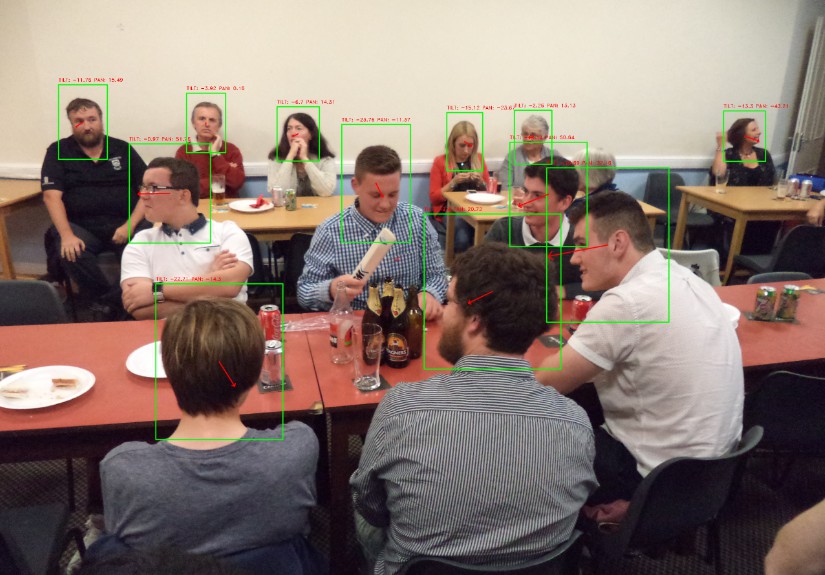RealHePoNet
a robust single-stage ConvNet for head pose estimation in the wild.

Work by Rafael Berral-Soler, directed by Manuel J. Marin-Jimenez, Francisco J. Madrid-Cuevas and Rafael Muñoz-Salinas. If you find useful this code, please, cite the following paper:
@misc{berral2020realheponet,
title={RealHePoNet: a robust single-stage ConvNet for head pose estimation in the wild},
author={Rafael Berral-Soler and Francisco J. Madrid-Cuevas and Rafael Mu\~noz-Salinas and Manuel J. Mar\'in-Jim\'enez},
year={2020},
eprint={2011.01890},
archivePrefix={arXiv},
note={Accepted for publication at NCAA},
primaryClass={cs.CV}
}
The pose estimator models developed on this project are compared with the architectures on the following article:
M. Patacchiola y A. Cangelosi. Head pose estimation in the wild using convolutional neural networks and adaptive gradient methods. Pattern Recognition, 71, June 2017.
Old code for this project can be downloaded here (only for archiving reasons).
Notes
-
In order to use this model, you MUST import
models/keras_ssd512.py,bounding_box_utilsandkeras_layersfrom the Keras implementation of Single-Shot Multibox Detector by Pierluigi Ferrari found here. These files must be placed in the root of the cloned repository directory. -
The original MatConvNet head detector model can be obtained here, work by Pablo Medina-Suarez and Manuel J. Marin-Jimenez. It must be placed on the
models/directory on the root of the cloned repository directory, and converted by running the scriptconvert_ssd_512.py. -
SSD model converter can also be obtained as a standalone software here.
-
In order to use the model and code included in this repository, it may be useful to update your PYTHONPATH. Provided you cloned this repository at ~/libs/headpose_final:
export PYTHONPATH=$PYTHONPATH:~/libs/headpose_final/:~/libs/headpose_final/models/
Software requirements
- OS: Ubuntu 16.04 or later (and derivatives), Windows 7 or later, macOS 10.12.6 or later (no GPU support).
- Python: Version 3.7.6.
- NVIDIA Software: GPU Drivers (410.x or later), CUDA (10.0) and cuDNN (7.4.1 or later for CUDA 10.0).
- TensorFlow: with or without GPU support, versión 1.14.0.
- Keras: Version 2.2.4.
- OpenCV: Version 4.1.0.25.
- Other Python libraries: glob2 (0.7), numpy (1.18.1), pandas (1.0.1), pillow (7.0.0), scikit-learn (0.22.2).
Quick Start guide
-
Clone this repository to a directory of your choice.
git clone https://github.com/rafabs97/headpose_final <directory> -
Install all required libraries. You can do this manually or using the requirements file included in this repository (WARNING: Potentially outdated).
pip install -r <directory>/requirements.txt -
Place
models/keras_ssd512.py,bounding_box_utilsandkeras_layersfrom here at the root of the cloned repository directory. -
Place
models/head-detector.matfrom here on themodels/directory on the root of the cloned repository directory. -
Run the script
convert_ssd_512.py. -
Run the script
demo_image.py. The output should match the demo output at the top of this page.
Comparison
We´ve added the code we used to compare our model with the one by Patacchiola et al. that can be found here. In order to use it:
- Place
deepgaze/face_detection.pyanddeepgaze/head_pose_estimation.pyfrom the previous repository on thecomparison_mpatacchiola/directory on the root of the cloned repository directory.- You may need to replace any reference to cv2.cv.CV_HAAR_SCALE_IMAGE to cv2.CASCADE_SCALE_IMAGE in
face_detection.py. - You can remove the dlib verification and the entire PnpHeadPoseEstimator from
head_pose_estimation.py, as it won't be used in the comparison.
- You may need to replace any reference to cv2.cv.CV_HAAR_SCALE_IMAGE to cv2.CASCADE_SCALE_IMAGE in
- Place
etc/tensorflow/head_pose/tilt/andetc/tensorflow/head_pose/pan/from the same repository on thecomparison_mpatacchiola/models/directory of the cloned repository directory (create the directory if needed). - Place
etc/xml/haarcascade_frontalface_alt.xmlandetc/xml/haarcascade_profileface.xmlfrom the same repository on thecomparison_mpatacchiola/modelsdirectory of the cloned repository directory.
The functions of the scripts contained are the following:
- Processed dataset for the comparison have been obtained using the script
clean_aflw.pyon thecomparison_mpatacchiola/directory (scriptsclean_pointing04.pyandclean_all.pycan be used to process the Pointing'04 dataset and to obtain the combined dataset in the same way we processed the data for our training, but using as head detector the Viola-Jones detector). - Script
match_datasets.pycan be used to naïvely extract a subset from a dataset appearing on a second dataset, based only on the tilt and pan head pose values (we have used it to match pictures from the AFLW dataset, as it should be rare to find repeating values in that dataset). - We used script
test_on_dataset.pyto get the mean error of the models by
Patacchiola et al. over the dataset obtained using the previous scripts.
Additionally, we have included 2 scripts in order to test and compare the performance of our model with the Hopenet model that can be found here. In order to use them:
- Place
code/hopenet.pyfrom the previous repository on thecomparison_hopenet/directory on the root of the cloned repository directory. - Download one of the models from the Hopenet repository (stored on Google Drive); place it on the
models/directory on the root of the cloned repository directory.
The scripts are the following:
- Script
test_on_image_hopenet.pyallows to get a demo prediction using the Hopenet model, and show it on screen. - Script
match_datasets.pyperforms the same function as in the previous comparison, but it has been modified to be compatible with the Dockerface detector output. - We used script
test_on_dataset.pyto get the mean error of the Hopenet model over the datasets obtained using the previous scripts.



